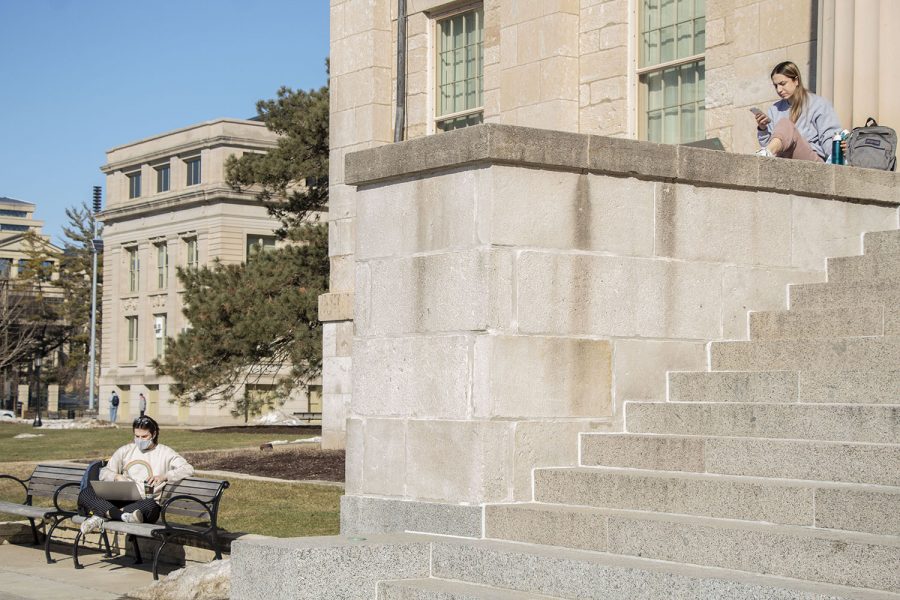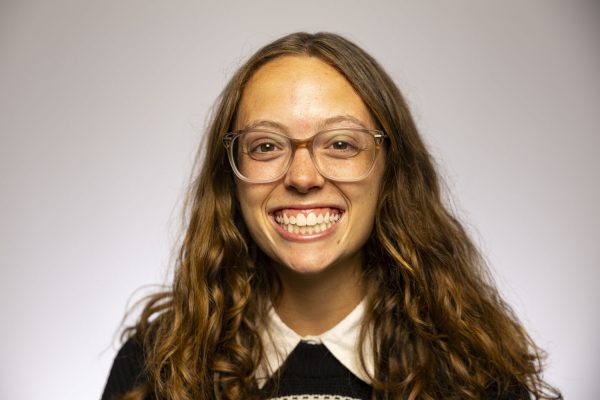Students navigated engaging in campus activities at the University of Iowa this year often without common campus space
A deadly pandemic shifted a normally bustling campus culture online, but after a year of social distancing, Zoom trivia, and virtual lectures, some organizations plan to bring this new virtual flexibility into a post-pandemic world
Two students, Nick Fitzpatrick (left) and Kourany Katzen (right) are seen on and near the Old Capitol Building on Tuesday, March 3, 2021, University of Iowa’s instructional day.
March 16, 2021
First-year Maddison Smith expected her first Hawkeye college experience to be filled with testing out new eateries and meeting new friends in her residence hall during the fall. After all, her high school canceled the graduation ceremony and stopped spring activities, including a senior prom.
Campus would be the bustling complex of residence halls and stately buildings she remembers visiting, or so she thought. But Smith’s first year on campus was nothing like she expected.
“I thought by the time I moved in, it would be fine,” Smith said.
The Davenport native moved into Catlett Hall this fall, but traveled home two weeks later after a COVID-19 scare. She said she felt isolated with most of her classes online because of fewer opportunities to get to know her classmates and have one-on-one experiences with her professors.
Feeling hopeful for an anticipated vaccine rollout, Smith came back to campus in the spring. Two weeks into the semester, she caught exactly what she’d moved home to avoid — the coronavirus.
As a music major studying music therapy, Smith said she often feels she’s missing out on some crucial parts to her education by not learning in person. Her major has four main focuses — piano, percussion, guitar, and voice. Smith never took piano lessons. So, she said, with technical Zoom mishaps and few opportunities for face-to-face feedback, she’s basically teaching herself the instrument.
“[I feel like] I am not getting everything I am paying for by teaching myself,” Smith said.
Smith is one student among tens of thousands at Iowa that experienced most classes online. Although the UI charted a primarily in-person fall 2020, rising cases and faculty concerns caused previously in-person activities to shift to a virtual format, meaning by Thanksgiving break, 76 percent of undergraduate credit hours were held online. This spring, 72 percent are online.
But administrators say the UI this fall is moving back to what it best offers — a residential campus experience. Navigating student support through a virtual campus when Iowa’s history and practice rested in in-person instruction required a shift in approach, Associate Provost of Undergraduate Education Tanya Uden-Holman said. For example, adding a virtual supplemental instruction option could help better equip students away from campus in the future.
“Supplemental instruction in the pre-COVID days, that was at the IMU, and students would go down to the IMU and work on different classes,” Uden-Holman said. “Hopefully, we can go back to that being residential, but I can see us possibly having a virtual component as well.”
Despite the obstacles she’s hurdled in her first year on campus, Smith said she encountered many encouraging professors that provide accommodations to help alleviate the barriers to online learning. Some professors would offer socially distanced spaces for music or opportunities to meet outside of class for music development.
Smith is not alone in having a first UI experience consumed by the pandemic thus far. Over the course of her tenure so far, Vice President for Student Life Sarah Hansen has overseen the connections between faculty and students done mostly online.
Hansen was announced in March 2020 as the new vice president for Student Life search, after former VP Melissa Shivers departed for a role at Ohio State University.
The self-described “COVID-era VP” said the UI took a huge hit financially, challenging the ability to do campus engagement projects this year. As previously reported in the The Daily Iowan, the UI’s estimated $83.4 million revenue loss stems from a $50-60 million loss in UI athletics, $13.7 million in refunds and lost revenue, $14.8 million in the General Education for tuition revenue, and a reduction of $3.1 million in state general fund allocations.
Everything has changed for individuals at the UI, Hansen said, from a virtual Dance Marathon, to online cultural center celebrations, and changes in services such as counseling.
“One of the lessons learned for me is that student engagement is a continuum, not a dichotomy,” Hansen said.
Bringing valuable experiences to students on campus is something the Lecture Committee — the UI’s committee tasked with bringing “thought-provoking” speakers to campus — has always put as their No. 1 priority. This year, safety of the students, staff and lecturers from a spreadable virus was a key factor they’d never navigated before when lining up speakers for campus.
Co-chair of the Lecture Committee Hannah Shrader said having this role this past year has meant being committed to flexibility. The committee held all its events online and met virtually since cases were first identified in Johnson County in early March.
“Because of the virtual space, we have been able to bring some incredible speakers like Laverne Cox and David Quammen,” she said.
Holding lectures online posed new challenges, she said, since none of the committee members had experience with running large virtual events.
But there were some silver linings to the lecture events shifting virtual. Online accessibility attracted larger audiences this year, and allowed the team to host higher-cost speakers, co-chair for the UI Lecture Committee Jocelyn Roof said.
“We have been able to bring incredible and high-profile speakers this year — much bigger names than in a typical year,” Roof said.
Although moving completely virtual has brought unique challenges, the team has continued reaching out to fellow virtually run groups to make sure the lectures reach as broad an audience as possible.
“We have ramped up our social media presence, sent emails to departments, and have broadened our marketing materials to fully cover the west side and east side,” Shrader said. “Committee members also reach out to their friends, families, and classmates to invite them personally.”
As the UI moves beyond the pandemic, Shrader said holding hybrid meetings and events is definitely on the table so that everyone can be involved in the way that works best for them.
Learning about opportunities — like serving on the lecture committee — was put on hold like the rest of on-campus life last March. Senior Associate Director of Admissions Thomas Paulsen said the university transitioned overnight from on-campus to virtual visits — the day after campus shut down, Paulsen said the UI hosted a virtual informational event.
“We wanted to make sure everyone could have all the information they needed as if they were to come on campus,” he said.
One upside to virtual campus visits was the ability to give families the closest experience to campus free of charge. Admissions was also able to reach students and families from afar more easily.
Since COVID-19 conditions have started to improve on campus and weather has warmed, socially distanced outdoor campus walking tours have begun.
“It is a way for families to come in and do more,” Paulsen said. “Virtual engagement is OK, but you cannot really smell and taste and hear the sights of campus and of Iowa City like you can when you are walking through campus and into downtown.”
Looking back on this past year, Paulsen has learned a lot not only about his fellow staff members and himself, but students as well.
“I think students are resilient,” he said. “I have found strength in my colleagues and working with families who have overcome barriers and who have had challenges.”
Both Smith and Paulsen are finding hope in the increasing vaccine rollouts, and for Smith, more opportunities for in-person activities. Because of this, she said she is beginning to finally settle in at Iowa.
“I feel more at home this spring than I did in the fall,” Smith said.
















